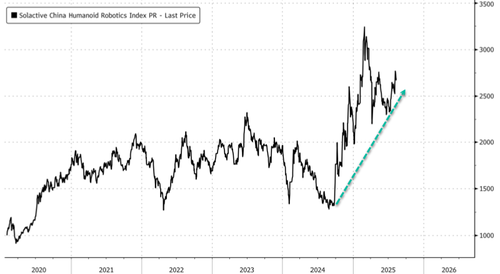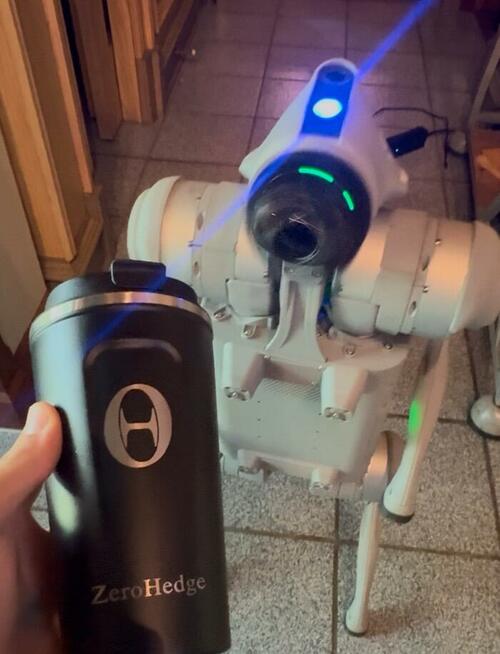Goldman Finds “Inflection Point” With Humanoid Robots; We Tested Unitree’s Robodog
Goldman analyst Jacqueline Du attended the 2025 World Robot Conference (WRC) in Beijing, China, this past weekend and spoke with executives from some of the top humanoid robot companies to gauge the state of the industry, with the overall consensus that the “ChatGPT moment” for these robots is not far away.
Chinese humanoids game is insane! 🥡
At the 2025 World Robot Conference in Beijing, @UBTECHRobotics unveiled the Walker S2, the world’s first humanoid robot with autonomous battery swapping, completing the process in just three minutes.
UBTECH says this capability enables 24/7… pic.twitter.com/fpMSCdlM7v
— Lukas Ziegler (@lukas_m_ziegler) August 11, 2025
Du spoke with CEOs, CFOs, COOs, research heads, product VPs, and capital market managers from nine major humanoid robot companies, including Astribot, Booster Robotics, Galbot, Kepler, LimX, Paxini, RobotEra, Spirit.ai, and UBTech.
The World Robot Conference 2025 opened in Beijing on Friday, as a robotic host invited attendees to jointly inaugurate the event. The expo of the World Robot Conference features over 1,500 exhibits from more than 200 leading domestic and international robotics companies,… pic.twitter.com/4ABzwuZ9YX
— Global Times (@globaltimesnews) August 8, 2025
What she found is that consumer interest in humanoid robots is beginning to rise. Her view is that the tech inflection point for these bots entering the real world is still 2 to 3 years away – certainly less than ten. At least 20 new humanoid robots were launched at the event.
Here are Du’s top takeaways from WRC:
1. Very strong family/consumer visitor traffic that we observed at the event as compared to 2025 WAIC in Shanghai. While the latter was more focused on broad AI academic and industry development topics with humanoid robot as a subset, and thus had more professional visitors, WRC is completely dedicated to robot technologies and product demos. This in our view suggests that near-term educational, companion and entertainment demand potential could be strong (aside from scientific study, AI model training, government, developers and stage performance demand etc). In the long term, we see this as an early indicator that as long as robot products are useful, affordable and safe enough, consumer demand potential could be very significant aside from manufacturing demand. Recently Unitree launched its new product R1 that is priced at Rmb39,900 (121cm/25kg/26 DOF) and Engine.ai announced plans to launch SA02 (125cm/25kg/26+2 DOF) soon at Rmb38,500, both of which could be targeting these demands with product specs that are also much more simplified.
2. Regarding the technology inflection point, the most positive comments we heard suggest that at least 1-2 years are still required to scale up data and enhance models for reinforcement learning (RL), or to transition to end-to-end operations after 1-2 years of rule-based operation. This is primarily because industrial settings are difficult to simulate, potentially requiring up to 70-80% of high-quality real-world data for effective training, per some comments. We also heard about practices such as multi-modal remote operation by humans as a bridge solution, provided low latency can be ensured (with two companies citing Tesla’s new diner in Los Angeles where Optimus robots were observed serving popcorn). During his speech at the opening ceremony, Unitree CEO Wang Xingxing defined the robot’s “ChatGPT moment” as actually being able to complete tasks with generalized skillsets in a completely new environment, which he said is at least 2-3 years away, but not more than 10 years away.
That said, Google’s new AI video generation model, Veo3, introduced in May 2025, which notably creates and incorporates audio (including dialogue, sound effects, and background music) and excels from text and image prompting to real-world physics and accurate lip-syncing, presents an interesting discussion point among robot companies. Its capabilities have raised the question of whether its underlying AI architecture could be even more optimal than Vision-Language-Action (VLA) models combined with Reinforcement Learning (RL), which some have regarded as a primary AI solution for robotics and embodied AI since early this year. Therefore, we highlight that investors should be aware of potential product redesign risk given the ongoing, rapid co-evolution between software and hardware structures, as these two elements remain intrinsically linked in AI development. However, we are encouraged to see the industry’s swift progress, with new advancements emerging every couple of months.
A side note is that Nvidia has been very proactive at WRC, delivering keynote speech/seminars and showcasing its strategic initiatives in Physical AI and General-purpose Robotics, with its full-stack suite that encompasses cloud-scale model training, physics-based simulation (e.g., Isaac Sim/Lab) for synthetic data generation, and real-time edge AI deployment (e.g., Jetson AGX Thor). They have also recently newly introduced Cosmos Reason, an advanced Vision Language Model (VLM) designed to imbue robots with common sense and the ability to understand real-world scenarios. It is worth noting that almost every robot product is still using Jetson AGX Thor or the broader Jetson platform, per our checks.
3. There have been 20+ new products launched around this event (in July/Aug) out of total ~50 humanoid robot exhibitors (alongside another ~120 industrial robots and component companies). We saw variations across wheel-based and bipedal robots (with full rotary actuators or combination of rotary+linear). Overall product performance (WBC or whole body control) has improved quite significantly vs our visits in Feb/May in terms of speed and smoothness. All live demos functioned well from those companies that we saw and we came away positively surprised on this front.
4. In terms of applications, there were four major directions that we perceived: a) for education, show-room guide and stage performance purposes; b) standard platform for developers and scientific study/AI training purposes; c) manufacturing & logistics; and d) consumer/elderly care/companion. a) and b) are currently contributing the bulk of the volumes while for c), we were informed by companies we met that success rates for selective tasks such as pick and place, sorting, assembly and inspection has now reached 80-99.5% with further improvement mainly to address long tail and abnormal situations; while regarding whether robot operation speed (reasoning & execution) can match that of customers’ product line, it seems that non-production line tasks are where those robot players are currently targeting in a pragmatic way to ramp up initial volumes, and also to adapt to future flexible manufacturing system (FMS) needs. We also learned that manufacturers value whole system efficiency (e.g. multi-robot collaboration) more than single robot efficiency against single human labor on the same task. An 18-month payback is considered reasonable by customers to place orders, per one company’s comment.
5. On cost reduction, we perceived that among those robot players, domestic component ratio appears quite high (possibly ~80% already). They have also worked on the design optimization aspect this year to further lower cost with some hardware specs being lowered, we noticed. Going forward, volume leverage remains the key to bring the cost curve down.
6. In terms of recent government subsidies news, media reports suggest consumer purchase subsidies at Rmb1,500 per unit (on a single purchase exceeding Rmb10,000) and corporate purchase subsidies at Rmb250k per unit (on a single purchase exceeding Rmb5mn). These discounts are for in-store purchases at the “E-Town Robot Consumption Festival” in Beijing, which will run from Aug 2 to Aug 17. Online discounts are also available on JD.com: consumers and enterprises alike can get Rmb 600 off orders greater than Rmb 6,000, and Rmb 50 off orders greater than Rmb 500. (news link, link).
In markets, the Solactive China Humanoid Robotics Index – a thematic equity index tracking Chinese companies involved in the commercialization of humanoid and robotics technologies – is up 27.5% on the year.
The index jumped last week on news of Chinese robotics firm Unitree’s new robotic dog called “A2 Stellar Hunter.”
Unitree Introducing | Unitree A2 Stellar Hunter 🤩
Total weight: ~37kg | Unloaded range: ~20km
Lighter, Stronger and Faster. Engineered for Industrial Applications. pic.twitter.com/Rqpa7EkU0B— Unitree (@UnitreeRobotics) August 5, 2025
Our coverage focuses on a ‘Skynet-like system’ materializing in the years ahead:
-
Goldman’s Chat With Top Robotics Firm Reveals Skynet Humanoid Timeline
-
“Here Come Humanoids”: Morgan Stanley Braces For The Looming Phase Shift in AI
-
China Warns of Rogue Robot Troops Unleashing Terminator-Style “Indiscriminate Killings”
-
China Humanoid Robotics Index Jumps After Unitree Debuts “Stellar Hunter”
-
Meta Plans For New AI Humanoid Robot For “Household Chores”; Headline Fuels Stock Rally
We tested the Unitree Go2 Quadruped Robot.
New fear unlocked… it stands and everything. What should we do with it next? Flamethrower?
Tyler Durden
Mon, 08/11/2025 – 18:00ZeroHedge News







 T1
T1


